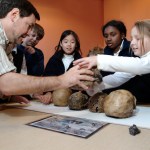Smithsonian
In the wake of the Willie Soon scandal, scientists are taking a hard look at the Smithsonian and other institutions at the forefront of research and public outreach. Should these organizations really be supported by industrialists who deny that carbon emissions continue to warm the planet, disrupt the climate, amplify extreme weather, and threaten to swallow us in a deluge of melted ice and presumably locusts? For that matter, should exhibits on evolution be subject to the whims of donors who insist the Earth is only six thousand years old? If not, where will less ideologically…
Let me start off by saying something you may not know. The big corporations and the 1%ers you have learned to hate fund many of the projects you've learned to love. I have not checked lately, but Murdoch and FOX corporation for several years in a row funded at a 50% or 60% level virtually all of the National Geographic specials produced. Major museums known for their great exhibits are often funded by the very corporations or individuals that the people who love those exhibits are (often justifiably) suspicious of. The great importance of private corporate or individual funding is also a…
The panda bear cub recently born at the Smithsonian Zoo is approaching her 100th day of life. Following Chinese tradition, the zoo will be announcing her name on December 1st.
In the meantime, the zoo is asking for your help in choosing her name by casting your vote using the online poll that can be found here.
The finalists are:
Bao Bao (宝宝): Precious, treasure.
Ling Hua (玲花): Darling, delicate flower.
Long Yun (龙韵): Long is the Chinese symbol of the dragon; Yun means charming. Combined this represents a sign of luck for panda cooperation between China and the United States.
Mulan (木兰):…
Scientists at the Smithsonian National Zoo have now confirmed that the new panda bear cub born on August 23rd is a girl and Tian Tian is her father.
Image of panda bear cub at its first exam from the National Zoo.
Exciting news from the Smithsonian National Zoological Park! Mei, a giant panda bear at the zoo has given birth to a cub weighing in at 137 grams (~4.83 ounces)-too cute!! DNA tests will determine the sex as well as the paternity of the panda cub, which is either Tian Tian from the National Zoo or Gao Gao from the San Diego Zoo.
You can follow the Twitter feed from the Smithsonian here: #cubwatch in additon to checking out the live panda cam at the zoo.
Study hard and get this guy's job:
I love that book, but when I was a kid they didn't have dinosaurs yet.
Last week, I was fortunate to be able to attend the opening of a Smithsonian Museum of Natural History exhibit dedicated to the rescue of 33 miners from the San José mine in Chile, and meet two of miners whose story captivated the world as they endured 69 days underground following a mine explosion. Carlos Barrios, Jorge Galleguillos, José HenrÃquez, and Mario Sepúlveda traveled to DC for the opening of "Against All Odds: Rescue at the Chilean Mine," a small but powerful exhibit whose centerpiece is one of the capsules built to haul the miners up 2,000 feet through the narrow shaft drilled…
Check out this article in the Huffinton Post by one of the USA Science and Engineering Festival's Nifty Fifty speakers Alan I. Leshner.
One of the most impressive aspects of the human origins exhibit at the Smithsonian's National Museum of Natural History -- along with the only Neanderthal skeleton in the United States and realistic reconstructions of our ancestors -- is the completely interactive character of the hall. Visitors are encouraged to engage with trained volunteers, create self-portraits of themselves as early hominids, and, most importantly, to question what it means to be…
Earlier this summer, we had a chance to ask Sally Kuhn Sennert of the Smithsonian Institution/USGS Global Volcanism Program questions about her job as the main writer of the well-loved Weekly Volcanic Activity Report. Well, now here are the answers!
Sally Kuhn Sennert of the Global Volcanism Program in front of Mt. Rainier, Washington.
Q&A Sally Kuhn Sennert:
Q: Could you describe how you go about putting together the weekly update?
A: If time permits, I would start to gather information on Friday when particular sources post their weekly summaries. The majority of the information…
Lots of little pieces of news I've run across ... time to play a little catch up.
Stromboli: A volcano after Don Ho's heart.
Every once in a while, my RSS feeds will dredge up some articles from years gone by ... and this week there were two New York Times pieces that are a few years old, but interesting nevertheless. The first is about research conducted by Dr. Robert Sohn at WHOI on explosive undersea eruptions. The second is work by Corr and Vaughan about finding subglacial volcanism in Antarctica. Both are interesting reads if you missed them (like I did) the first time around.…
So, I'm a little late with this thanks to a little hiatus, but I thought I would post the latest GVP Weekly Volcanic Activity Report. Thanks again to the Smithsonian, USGS and especially Sally Kuhn Sennert!
Some highlights include:
There were more ash explosions spotted at Ebeko in Kamchatka, producing ~1.8 km (5,900 foot) ash columns. This activity prompted KVERT to raise the Alert Status to Yellow. This goes along with news from a pile of other Kamchatka/Kuril Island volcanoes: Gorely, Tiatia, Karymsky, Kliuchevskoi and Shiveluch.
More activity at Arenal in Costa Rica - its almost always…
Just a reminder, if you any questions for Sally Kuhn Sennert of the Smithsonian/USGS Global Volcanism Program - about the Weekly Report, about life at the GVP, about volcanoes - be sure to send them to me soon at .
Now, on to this week's update!
Some highlights (not including Gorely):
Lahars from Tungurahua in Ecuador moved blocks upwards of 2 m in diameter downstream over the last week and ash fall was reported over 20 km from the volcano's vent. For some reason, FoxNews decided to use an image of Tungurahua for an article on stats of natural disasters in 2009 - nice image, but the volcano…
The latest news from the world of volcanoes, brought to us by the Global Volcanism Program, USGS and the Smithsonian Institution. They are also brought to us by Sally Kuhn Sennert - and if you have a question for her about her job at the GVP preparing the Weekly Volcanic Activity Report and all things volcanic (and hopefully it won't end like another recent volcanically-mitigated interview).
Some highlights (not including Gorely and Sakurajima):
Ioto (aka Iwojima) in the Volcano Islands of Japan produced an ash plume of unknown height. The volcano has frequent phreatic eruptions and abundant…
As a part of my continuing Q&A series, I am pleased to announce that Sally Kuhn Sennert, compiler and author of the weekly Global Volcanism Program Volcanic Activity Reports, is the next up to take your questions. A little bit about Sally:
Sally Kuhn Sennert graduated with a Bachelor's degree in Anthropology from the University of Pittsburgh in 1997. She worked with non-human primates for several years before deciding to switch gears and pursue her first love, Geology. She returned to the University of Pittsburgh, and completed her Master's degree in 2003 under the direction of Dr. Mike…
Have guests in town, so I'm a little busy, but you can hopefully keep entertained with the latest Smithsonian/USGS Global Volcanism Program Volcanic Activity Report.
Chile's Melimoyu volcano.
The highlights (not including Taal and Eyjafjallajökull) include:
Alaska's Cleveland volcano has been reduced to and alert status of "unassigned" (used when a volcano is not closely monitored so AVO doesn't know what exactly is "background") after a few weeks of activity. The same was done for the submarine volcano south of Sarigan in the Marianas Islands after no signs of activity since the eruption…
The latest update from the Smithsonian/USGS Global Volcanism Program!
Highlights (not including Taal, Eyjafjallajökull and Bezymianny) include:
Another thermal anomaly was spotted on an Kuril Island volcano - this one being Tiatia. The volcano has no seismic monitoring network, so the thermal anomaly is all that has been observed.
Lava flows and strombolian explosions continue at Guatemala's Pacaya. Some of the explosions have launched bombs hundreds of meters into the air.
Kliuchevskoi was another busy Russian volcano, with a large thermal anomaly and ash explosions that produced a plume…
The level of news-frenzy on some of the recent volcanic eruptions has died down, but if you're looking to see information on the many rumbling going on worldwide, look no further. Here is this week's Volcanic Activity Report put together by Sally Kuhn Sennert of the Global Volcanism Program.
Highlights - not including Pacaya, Yasur, Tungurahua and our friend in Iceland - include:
The eruption in the Marianas apparently came from South Sarigan volcano - at least according to the best guess by folks who work in the Marianas. This submarine volcano apparently shows evidence of young lava flows…
The latest Weekly Volcanic Activity Report from our friends at the Smithsonian Global Volcanism Program and the USGS.
Highlights (not including Eyjafjallajökull - you can check the latest IMO update on that eruption and the latest VAAC ash advisories.):
Villarrica in Chile was raised from Alert Level 1 to 2 by the Chilean SERNAGEOMIN after an increase in seismicity, a rise in the lava lake levels at the summit and more vigorous fumarolic activity.
In the first update in a while, a small ash plume was noticed at Chaiten in Chile, rising to ~1.8 km (8,000 feet) from the new domes.
Karymsky in…
Ah yes, a reminder that there are other volcanoes erupting around the world than Eyjafjallajökull - but yes, it is true! Here is the latest USGS/Smithsonian Global Volcanism Program Weekly Volcanic Activity Report!
Highlights (not including Iceland) include:
Another volcano in the Kuril Islands of Russia is showing signs of, well, something. Ketoi was noticed to be experiencing increased fumarolic activity according to satellite images. Ketoi hosts a Pleistocene caldera but has had three historic eruptions over the last few centuries, most recently in 1960, and all of which were explosive…
News!
Colima in Mexico erupting in 2008.
The current activity at Eyjafjallajökull is more-or-less unchanged, with strombolian activity producing a 3-4 km tall ash-and-steam plume and the lava flows at the crater moving northward towards the GÃgjökull glacier. You can check out an extensive page on the state of this eruption at the Nordic Volcanological Center - along with a new page with thermal and LIDAR information on the eruption from France.
The Icelandic Met Office notes that the lava has been producing meltwater from the glacier - which many Eruptions readers have noticed as floods…



